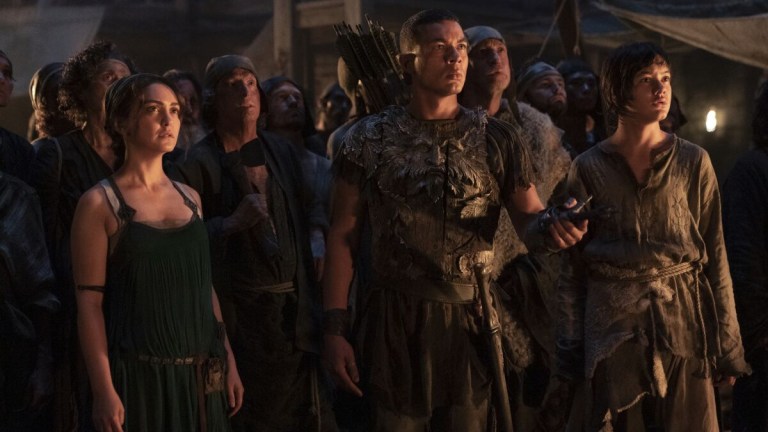The Rings of Power Just Set Up Its Own Helm’s Deep Moment
The Rings of Power season 1's inevitable final battle seems a bit familiar...

This Lord of the Rings article contains spoilers for The Rings of Power.
Four episodes in, it’s clear The Rings of Power is playing many of the same notes that Peter Jackson did back in the early 2000s. Like in the award-winning film trilogy, Sauron is the main villain, a forbidden romance between a human and an elf is the central love story, an heir to the throne of man in Middle-earth is running from his destiny, and Gandalf (we assume) is hanging out with Hobbits. Mind you, some of this repetition is just the way J.R.R. Tolkien‘s legendarium works, like the way Aragorn and Arwen‘s story and a similar tale from the First Age mirror each other in the books. But that certain beats on the show feel instantly recognizable to nostalgic movie fans is likely no accident, either. And as the show progresses, the Second Age is introducing a few more familiar situations into the mix.
Consider the latest developments in “The Great Wave.” Galadriel spends much of the episode trying to convince Numenor, the greatest kingdom of man, to defend their Middle-earth brethren, not unlike Aragon and Gandalf trying to get Rohan and Gondor to fight alongside each other against Mordor. Meanwhile, the dwarves are digging too deep in the mines of Moria, which we know will eventually mean their doom by the time of the Lord of the Rings trilogy. Then there’s what’s going on in the Southlands, which seems to set up the show’s most overt nod to the films (and Tolkien’s book trilogy) yet.
Midway through the season, things are looking dire for the men who call the Southlands their home. Driven away from their villages and forced to flee to the elven watchtower of Ostirith, Bronwyn and her kin are not only defenseless to stop an orc invasion but are also going hungry. The latter seems to be temporarily remedied by Bronwyn’s son Theo, who heads back to their village to scavenge for food. It’s while scooping rice off the floor and into a sack that Theo has a run in with a group of orcs who are searching for the very sword that he’s kept hidden since the start of the series. Captured and about to meet his demise at the hands of one particularly bloodthirsty orc, Theo is saved at the last second by Arondir.
The best sequence of the episode sees the Silvan Elf fending off a horde of orcs with his bow as Theo and Bronwyn run through the woods to reach a sunlit clearing where their pursuers can’t follow. By the end of the episode, Arondir, Bronwyn, and Theo have escaped but their trouble is far from over when they reach the watchtower. Arondir has brought back a message from Adar, the mysterious leader of the orc army terrorizing the Southlands.
According to Arondir, Adar let him go so that he could deliver an ultimatum: the men of the Southlands can either swear fealty to him and abandon all claim to their land or die. “And if we refuse?” asks Bronwyn. “He’s coming for Ostirith,” Arondir says gravely.
But whether they accept or refuse Adar’s offer, an attack is all but a certainty after the villain learns that the sword he seeks is being kept behind the walls of the watchtower. The stage seems set, then, for man’s last stand in the Southlands, a scenario that might feel more than a bit familiar to those fans who love the Battle of Helm’s Deep section of The Lord of the Rings.
If you’ve read or watched The Two Towers, you likely remember that this installment ends with a climactic battle at a massive, seemingly impregnable stone fortress, Rohan’s final defense against Saruman’s army of Uruk-hai. It’s here that Aragorn, Legolas, Gimli, King Theoden, and the people of Rohan make their final stand against the White Wizard, with the help of a battalion of elf soldiers from Lothlorien in the film version. But even all of these heroes aren’t enough to repel 10,000 Uruks carrying a bomb. And when the walls of the Hornburg are finally breached — for the first time ever, according to the history books of Middle-earth — it seems that all hope is lost for the kingdom of Rohan. That’s when Gandalf shows up with the cavalry, saving the day.
The Rings of Power seems to be setting up something equally dramatic for its (we assume) Battle of Ostirith — whose name combines the Elvish word “Ost” which means fortress, with “tirith” or guard. (It also calls back to Gondor cities Osgiliath and Minas Tirith.) While Adar’s orc forces far outnumber the people hiding in Ostirith, we also learn in “The Great Wave” that Numenor has decided to join Galadriel in her fight against the Sauron, and that they’ll be sailing to Middle-earth to aid the Southlands very soon. And with the Harfoots leading Almost Definitely Gandalf around Rhovanion, which borders the Southlands, there’s even the possibility The Rings of Power will give the wizard his first chance to rescue the people of Middle-earth from the forces of evil.
A last-ditch effort by brave men to defend their land from Sauron, and when all seems lost, the bright light of Numenor to pierce through the darkness. Sounds like a great way to pay tribute to one of the best sequences in all of Lord of the Rings.
We’ll find out for sure how it’s all going to go down when The Lord of the Rings: The Rings of Power returns this Friday on Amazon Prime Video.
